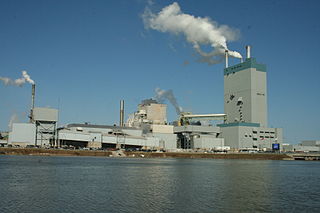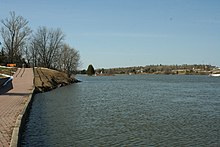
Dryden is the second-largest city in the Kenora District of Northwestern Ontario, Canada, located on Wabigoon Lake. It is the least populous community in Ontario incorporated as a city. The City of Dryden had a population of 7,749 and its population centre had a population of 5,586 in 2016.
The Weyerhaeuser Company is an American timberland company which owns nearly 12,400,000 acres of timberlands in the U.S., and manages an additional 14,000,000 acres of timberlands under long-term licenses in Canada. The company has manufactured wood products for over a century. It operates as a real estate investment trust (REIT). Weyerhaeuser is notable for litigating the 2018 Supreme Court case Weyerhaeuser Company v. United States Fish and Wildlife Service, in which Weyerhaeuser advocated for destroying one of the few remaining habitats which could sustain the critically endangered Mississippi gopher frog, so that the Company could profitably develop the land.

Domtar Corporation is a North American pulp and paper company that manufactures and markets wood fiber-based pulp and paper products. The company operates pulp mills and paper mills in Windsor, Quebec; Dryden, Ontario; Kamloops, British Columbia; Ashdown, Arkansas; Hawesville, Kentucky; Plymouth, North Carolina; Marlboro County, South Carolina; and Kingsport, Tennessee. While Domtar operated independently for several decades and was listed on the Toronto and New York stock exchanges, the company was acquired by Paper Excellence Group in November 2021 and has since operated as a subsidiary.

Mercury poisoning is a type of metal poisoning due to exposure to mercury. Symptoms depend upon the type, dose, method, and duration of exposure. They may include muscle weakness, poor coordination, numbness in the hands and feet, skin rashes, anxiety, memory problems, trouble speaking, trouble hearing, or trouble seeing. High-level exposure to methylmercury is known as Minamata disease. Methylmercury exposure in children may result in acrodynia in which the skin becomes pink and peels. Long-term complications may include kidney problems and decreased intelligence. The effects of long-term low-dose exposure to methylmercury are unclear.

The Penobscot River is a 109-mile-long (175 km) river in the U.S. state of Maine. Including the river's West Branch and South Branch increases the Penobscot's length to 264 miles (425 km), making it the second-longest river system in Maine and the longest entirely in the state. Its drainage basin contains 8,610 square miles (22,300 km2).

The Wabigoon River is a river in Kenora District in northwestern Ontario, Canada. It flows from Raleigh Lake past Dryden, Ontario on Wabigoon Lake to join the English River. The name "Wabigoon" comes from the Ojibwe waabigon, "marigold", or waabi-miigwan, "white feather".
Asubpeeschoseewagong First Nation is an Ojibwe First Nations band government who inhabit northern Kenora in Ontario, Canada. Their landbase is the 4,145 ha English River 21 Indian Reserve. It has a registered population of 1,595 as of October 2019, of which the on-reserve population was 971. As of October 2023, the community had a registered population of 1,608. They are a signatory to Treaty 3.
Ontario Minamata disease is a neurological syndrome caused by severe mercury poisoning. It occurred in the Canadian province of Ontario, in 1970, and severely affected two First Nation communities in Northwestern Ontario following consumption of local fish contaminated with mercury, and one First Nation in Southern Ontario due to illegal disposal of industrial chemical waste. The disease was named after the infamous case of severe mercury poisoning in the fishing community of Minamata, Japan, which became known as Minamata disease because it devastated only the residents of the community.

The presence of mercury in fish is a health concern for people who eat them, especially for women who are or may become pregnant, nursing mothers, and young children. Fish and shellfish concentrate mercury in their bodies, often in the form of methylmercury, a highly toxic organomercury compound. This element is known to bioaccumulate in humans, so bioaccumulation in seafood carries over into human populations, where it can result in mercury poisoning. Mercury is dangerous to both natural ecosystems and humans because it is a metal known to be highly toxic, especially due to its neurotoxic ability to damage the central nervous system.

The Great Lakes Paper Company was the operator of the largest and most modern pulp and paper manufacturing facility in the world. The Company employed over 4,000 in Northern Ontario, starting in 1924 as a pulp mill at Fort William, Ontario. Great Lakes had a highly developed social network within the company, including a children's Christmas party held at a local arena, and an annual picnic held at a local park, as well as many sports teams and other social groups. The company's working environment was enhanced by cultural diversity. For example under the Government of Canada's immigration policy, the "Close Relatives Scheme" resulted in over 400 Ukrainian refugees being employed as workers after World War II.

The environmental effects of paper are significant, which has led to changes in industry and behaviour at both business and personal levels. With the use of modern technology such as the printing press and the highly mechanized harvesting of wood, disposable paper became a relatively cheap commodity, which led to a high level of consumption and waste. The rise in global environmental issues such as air and water pollution, climate change, overflowing landfills and clearcutting have all lead to increased government regulations. There is now a trend towards sustainability in the pulp and paper industry as it moves to reduce clear cutting, water use, greenhouse gas emissions, fossil fuel consumption and clean up its influence on local water supplies and air pollution.
Waawaate Fobister (Anishinaabe) is a Canadian actor, dancer, playwright, choreographer, instructor, producer and storyteller, best known for their semi-autobiographical one-man play, Agokwe.
Mercury is a poisonous element found in various forms in Canada. It can be emitted in the atmosphere naturally and anthropogenically, the main cause of mercury emission in the environment. Mercury pollution has become a sensitive issue in Canada for the past few decades and many steps have been taken for prevention at local, national, and international levels. It has been found to have various negative health and environmental effects. Methylmercury is the most toxic form of mercury which is easily accessible as well as digestible by living organisms and it is this form of mercury causing serious harm to human and wildlife health.

Brian Branfireun is a Canadian environmental scientist. He held a Canada Research Chair (2010-2020) and is a professor at Western University. He studied climate change and directed a laboratory in Western's Biotron for the study of speciated trace metals in the environment such as mercury and arsenic.
In Canada, First Nations communities have been under long-term drinking water advisories (DWAs) for decades. A long-term drinking water advisory is an advisory that has been in place for over a year.

Grassy Narrows First Nation v. Ontario [2014] SCR 48, [2014] 2 S.C.R. 447 was a July 11, 2014 decision by the Supreme Court of Canada in case number 35379 in which an appeal made by the Government of Ontario was allowed. The result of Grassy Narrows v. Ontario, while legal, was deemed unfair by some to Grassy Narrows First Nation, as "it has put them in a situation of having negotiated with a party who then ceased to be a party when it came to honouring the agreement."

Mercury contamination in Grassy Narrows was an uncontrolled discharge of between 9,000 kilograms (20,000 lb) and 11,000 kilograms (24,000 lb) of mercury from the Dryden Mill's chloralkali plant in Dryden into the headwaters of the Wabigoon River in the Kenora District of Northwestern Ontario from 1962 until 1970. It was described as "one of the worst cases of environmental poisoning in Canadian history." The contamination poisoned many people in the Grassy Narrows First Nation and Whitedog First Nation communities
The Royal Commission on the Northern Environment was established by the Government of Ontario with J. E. J. Fahlgren as Commissioner. The final report and recommendations were submitted to the Ontario Ministry of the Attorney General on June 28, 1985.

Water pollution in Canada is generally local and regional in water-rich Canada, and most Canadians have "access to sufficient, affordable, and safe drinking water and adequate sanitation." Water pollution in Canada is caused by municipal sewage, urban runoff, industrial pollution and industrial waste, agricultural pollution, inadequate water infrastructure. This is a long-term threat in Canada due to "population growth, economic development, climate change, and scarce fresh water supplies in certain parts of the country."














